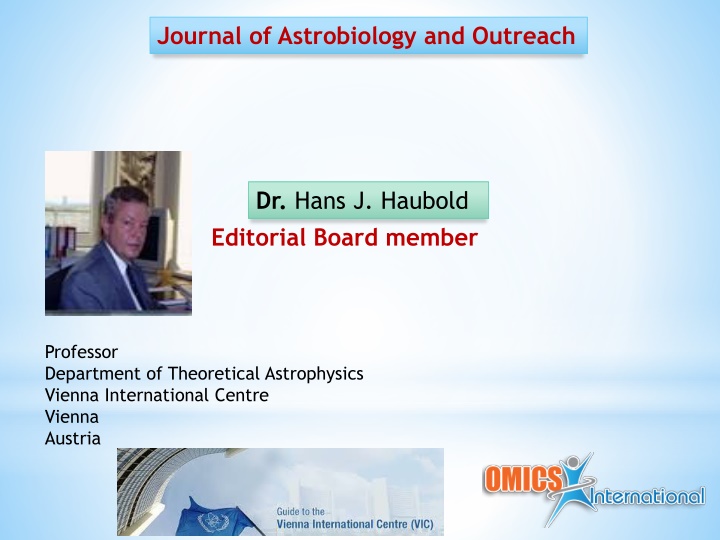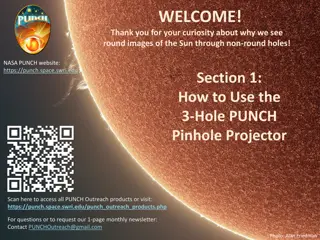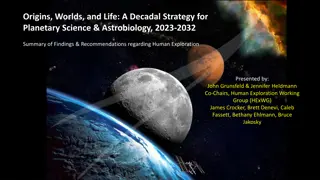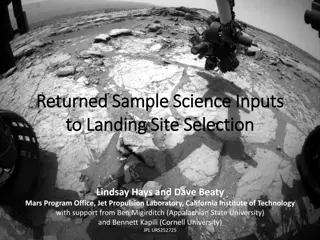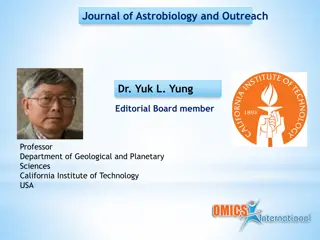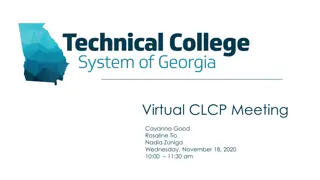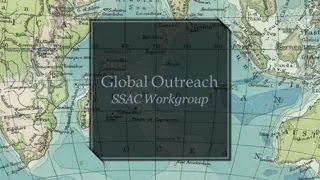Journal of Astrobiology and Outreach
Dr. Hans J. Haubold, a prominent figure in astrophysics, is a Professor at the Vienna International Centre in Austria. With research interests spanning astrophysics, planetary science, cosmology, astronomy, and space science, he has contributed significantly to the field. His recent publications cover topics like Mittag-Leffler functions, fractional kinetic equations, and special functions for applied scientists. This showcases his expertise and dedication to advancing our understanding of the cosmos.
Download Presentation

Please find below an Image/Link to download the presentation.
The content on the website is provided AS IS for your information and personal use only. It may not be sold, licensed, or shared on other websites without obtaining consent from the author.If you encounter any issues during the download, it is possible that the publisher has removed the file from their server.
You are allowed to download the files provided on this website for personal or commercial use, subject to the condition that they are used lawfully. All files are the property of their respective owners.
The content on the website is provided AS IS for your information and personal use only. It may not be sold, licensed, or shared on other websites without obtaining consent from the author.
E N D
Presentation Transcript
Journal of Astrobiology and Outreach Dr. Hans J. Haubold Editorial Board member Professor Department of Theoretical Astrophysics Vienna International Centre Vienna Austria
Dr. Hans J. Haubold * Biography Hans J. Haubold studied physics at the Technical University, Chemnitz, Germany, and received the PhD in 1980 and DSc 1984, both on topics of stellar astrophysics. From 1974 to 1990, he worked at the Institute for Astrophysics, Potsdam, Germany. In 1990, he accepted a post at the United Nations Programme on Space Applications, Office for Outer Space Affairs, United Nations, New York, USA (relocated to the United Nations Office at Vienna, Austria, in 1993) where he still works. Research interest in astrophysics, physics, mathematics, history of physics, and space education. Since 1983 he is also a Professor at the Centre for Mathematical Sciences, Pala, Kerala, India. He edited more than 10 volumes of workshop proceedings, is co- author of more than 10 books and 250 papers.
Research Interests Astrophysics, Planetary Science, Cosmology, Astronomy, Space Science
Recent Publications 1. Mittag-Leffler functions and their applicationsHJ Haubold, AM Mathai, RK Saxena, Journal of Applied Mathematics 2011 2. Further solutions of fractional reaction diffusion equations in terms of the h- function, HJ Haubold, AM Mathai, RK Saxena, Journal of Computational and applied Mathematics 235 (5), 1311-1316 3. Solutions of certain fractional kinetic equations and a fractional diffusion equation, RK Saxena, AM Mathai, HJ Haubold, Journal of Mathematical physics 51 (10), 103506 4. The H-function, AM Mathai, RK Saxena, HJ Haubold,Springer 5. Special functions for applied scientists, AM Mathai, HJ Haubold, Springer Science+ Business Media
The Planets The Planets There are 8 planets (Mercury, Venus, Earth, Mars, Jupiter, Saturn, Uranus, Neptune (mercury nearest and Pluto farthest from the Sun) that revolve around Sun in their specific orbits, which lie more or less in the Sun s equatorial plane. There are moons or natural satellites, which revolve around planets. It is natural to think that planetary bodies have evolved from the Sun and the moons from their central bodies. However earth s moon has been found to be older than earth and has its own history of evolution. The biggest planet Jupiter is more akin to Sun than to other planets. In fact Mercury, Venus and Mars show surface features similar to our moon. The planets can be divided into two categories. The inner planets: Mercury, Venus, Earth, Mars which have densities of the order of 5 or more and sizes comparable to that of earth.
The outer planets (Jupiter, Saturn, Uranus, Neptune) quite large in size and have low densities 1.5 (Jupiter like hence called Jovian planets). In our planetary system there are bodies which have little or no atmosphere and magnetic field (Moon, Mercury) bodies which have substantial atmospheres but very little or no magnetic field (Venus and Mars) and bodies having both atmosphere and intrinsic magnetic field (Earth, Jupiter) The solar flux expected at the orbit of planet outside its atmosphere, its albedo (measure of the reflectance of the surface) and effective computed temperature Teff are listed in Table 3. Actual temperature would depend on the presence or absence of atmosphere, sunlit or dark condition etc. For earth the actual temperature 288 K is warmer than the effective temperature.
Table 1: Planetary Data Planet Mean radius km Mean density gmcm3 Average distance from AU 0.39 0.72 1.00 1.52 5.2 9.5 20 30 Length of year- days Rotation period- days Inclination degree Sun Mercury Venus Earth Mars Jupiter Saturn Uranus Neptune 2439 6050 6371 3390 69500 58100 24500 24600 5.42 5.25 5.51 3.96 1.35 0.69 1.44 1.65 88 225 365 687 4330 10800 30700 60200 58.7 -243 1.00 1.03 0.41 0.43 -0.89 0.53 <28 <3 23.5 25 3.1 26.7 98.0 28.8
Table 2: Other planetary parameters Planet Area Earth=1 0.15 0.9 Mass Earth =1 0.05 0.81 Gravity Earth =1 0.37 0.89 Escape Vel. m/s 4.3 10.4 Atmosphere Mercury Venus Trace? CO2 (96%) +N2 (3.5%)+ SO2 (130 ppm) N2 (78%) + O2 (21%) +Ar (.9%) CO2 (95%) + N2 (2.7%) H2 (86%), He (14%), CH4 (0.2%) H2 (97%), He (3%), CH4 (0.2%) H2 (83%), He (15%), CH4 (2%) H2 (79%), He (18%), CH4 (3%) Earth Mars Jupiter Saturn Uranus Neptune 1.0 0.3 120 85 14 12 1.0 0.11 318 95 14 17 1.0 0.39 2.65 1.65 1.0 1.5 11.2 5.1 60.0 36.0 22.0 22.0
Table 3: Effective temperature of planets Solar flux 1016 erg/cm2/s 9.2 2.6 1.4 0.6 0.05 0.01 0.004 0.001 Teff (o K) Planet Albedo Mercury Venus Earth Mars Jupiter Saturn Uranus Neptune 0.06 0.71 0.38 0.17 0.73 0.76 0.93 0.84 442 244 253 216 87 63 33 32
Table 4: Magnetic field parameters of planets Magnetic dipole moment Me Planet Core radius km Magnetic dipole tilt degrees Magnetic dipole offset in planetary radii 0.2 - 0.07 - 0.1 < 0.05 0.3 0.55 3.1x10-4 <5x10-5 1 3x10-4 1.8x104 0.5x103 - Mercury Venus Earth Mars Jupiter Saturn Uranus Neptune ~1800 2.3 - 11.5 (15-20) 11 ~3000 3485 ~1700 ~52000 ~28000 1.5 0.5 58.6 46.8 - -
Table 5: Composition of dry air by volume at the earths surface N2 O2 Ar 78.09% 20.95 0.93 CO2 0.03 Ne 0.0018 He 0.00053 Kr 0.0001
According to Professor Haubolds research interest An overview on statistical techniques for the analytic evaluation of integrals for non-resonant, non-resonant depleted, non- resonant cut-off, non-resonant thermonuclear reaction rates. The techniques are based on statistical distribution theory and the theory of Meijer's G-function and Fox's H-function. He presented a computable solution of a fractional partial differential equation associated with a Riemann-Liouville derivative of fractional order as the time-derivative and Riesz- Feller fractional derivative as the space derivative. The method followed in deriving the solution is that of joint Laplace and Fourier transforms. The solution is derived in a closed and computable form in terms of the Hfunction. It provides an elegant extension of the results given earlier by Debnath, Chen et al., Haubold et al., Mainardi et al., Saxena et al., and Pagnini et al. sccreened, and resonant
The results obtained are presented in the form of four theorems. Some results associated with fractional Schr odinger equation and fractional diffusion-wave equation are also derived as special cases of the findings. The results are of interest to the physics of complex systems goverend by non-Gaussian, Non-Markovian, and non-Fickian phenomena. Stars are gravitationally stabilized fusion reactors changing their chemical composition while transforming light atomic nuclei into heavy ones. The atomic nuclei are supposed to be in thermal equilibrium with the ambient plasma. The majority of reactions among nuclei leading to a nuclear transformation are inhibited by the necessity for the charged participants to tunnel through their mutual Coulomb barrier.
Approved by E-signature:
OMICS International Open Access Membership OMICS International Open Access Membership enables academic and research institutions, funders and corporations to actively encourage open access in scholarly communication and the dissemination of research published by their authors. For more details and benefits, click on the link below: http://omicsonline.org/membership.php
